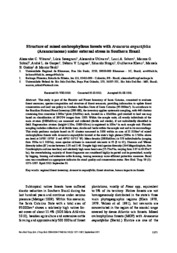Structure of mixed ombrophyllous forests with Araucaria angustifolia (Araucariaceae) under external stress in Southern Brazil.
Structure of mixed ombrophyllous forests with Araucaria angustifolia (Araucariaceae) under external stress in Southern Brazil.
Autoria: UHLMANN, A.
Resumo: This study is part of the Floristic and Forest Inventory of Santa Catarina, conceived to evaluate forest resources, species composition and structure of forest remnants, providing information to update forest conservation and land use policy in Southern Brazilian State of Santa Catarina (95 000km²). In accordance to the Brazilian National Forest Inventory (IFN-BR), the inventory applies systematic sampling, with 440 clusters containing four crosswise 1 000m² plots (20x50m) each, located on a 10x10km grid overlaid to land use map based on classification of SPOT-4 images from 2005. Within the sample units, all woody individuals of the main stratum (DBH?10cm) are measured and collected (fertile and sterile), if not undoubtedly identified in field. Regeneration stratum (height>1.50m; DBH<10cm) is registered in 100m² in each sample unit. Floristic sampling includes collection of all fertile trees, shrubs and herbs within the sample unit and in its surroundings. This study performs analysis based on 92 clusters measured in 2008 within an area of 32 320km² of mixed ombrophyllous forests with Araucaria angustifolia located at the state’s high plateau (500m to 1 560m above sea level at 26º00’-28º30’ S and 49º13’-51º23’ W). Mean density (DBH?10cm) is 578 individuals/ha (ranging from 85/ha to 1 310/ha), mean species richness in measured remnants is 35 (8 to 62), Shannon and Wiener diversity index (H’) varies between 1.05 and 3.48. Despite high total species diversity (364 Magnoliophyta, five Coniferophyta and one tree fern) and relatively high mean basal area (25.75m²/ha, varying from 3.87 to 68.85m²/ ha), the overwhelming majority of forest fragments are considered highly impacted and impoverished, mostly by logging, burning and extensive cattle farming, turning necessary more efficient protection measures. Basal area was considered an appropriate indicator for stand quality and conservation status.
Ano de publicação: 2011
Tipo de publicação: Artigo de periódico
Unidade: Embrapa Florestas
Observações
1 - Por padrão são exibidas publicações dos últimos 20 anos. Para encontrar publicações mais antigas, configure o filtro ano de publicação, colocando o ano a partir do qual você deseja encontrar publicações. O filtro está na coluna da esquerda na busca acima.
2 - Para ler algumas publicações da Embrapa (apenas as que estão em formato ePub), é necessário ter, no celular ou computador, um desses softwares gratuitos. Sistemas Android: Google Play Livros; IOS: iBooks; Windows e Linux: software Calibre.
Acesse outras publicações
Acesse a Base de Dados da Pesquisa Agropecuária (BDPA) para consultar o acervo completo das bibliotecas da Embrapa.

